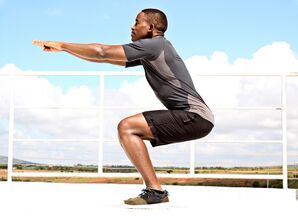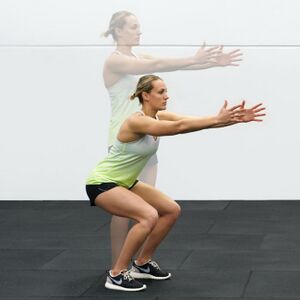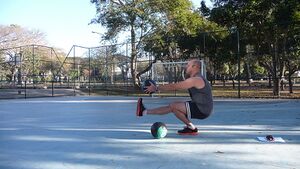Squat Exercise
Original Editor - Lucinda hampton
Top Contributors - Lucinda hampton and Matt Huey
Introduction[edit | edit source]
The squat is a dynamic movement and mimics daily living movements as well as sport movements.[1]
"The squat movement pattern is arguably one of the most primal and critical fundamental movements necessary to improve sport performance, to reduce injury risk and to support lifelong physical activity" (Meyer et al).[2]
When performed correctly, the squat exercise also increases metabolism, helps prevent injuries, strengthens the core, and improves balance and posture[3].
Screen client first re contraindications eg Anterior knee pain.
Technique[edit | edit source]
T0 performed a squat:
- Start with feet placed in subjects preferred position (to avoid extra stress upon the subject and to increase the external validity towards training). Shoulders at 90 degree flexion.
- The subject keeps their chest up, engaging abdominals, and shifts weight onto your heels as they push hips back into a sitting position.
- The subject flexes the knees down to a depth where the hip crease drops below the patella, keeping knees over, but not beyond, toes.
- Subject exhales and returns back up to the starting position.
Instructions to client are :
“Please stand upright with feet shoulder width apart. Squat down until you believe that the top of your thighs are parallel to the ground, and then return to the initial starting position. Perform 10 continuous repetitions at a consistent, moderate pace, or until you are instructed to stop.”
Target Muscles[edit | edit source]
Many lower body muscles are used;
In addition to the lower body, the squat also targets the core muscles eg rectus abdominis, obliques, transverse abdominis, and erector spinae.[3]
Assessment Tool[edit | edit source]
Performing a correct squat requires the upper and lower body to work in unison activating over an estimated 200 muscles. In addition to musculature stability and postural control, dysfunctional movement patterns can also be identified.
Many health professionals see the basic squat movement as a valuable primary physical training exercise, being a single compound exercise that is highly sensitive to highlight biomechanical deficits. Deficits identified during the back squat are either:
- Inefficient motor unit coordination or recruitment (neuromuscular), muscle weakness, strength asymmetry or joint instability (strength)
- Joint immobility or muscle tightness (mobility).
Common biomechanical deficits seen during the squat eg:
- Front View: Knees buckle inwards - Potential Dysfunction, Gluteus Medius/Maximus, external hip rotators; Arms bend at elbow or sway excessively forward - Potential Dysfunction: Thoracic or Shoulder mobility
- Side View: Ankle – Heels lift off floor, unable to achieve 15-20 degrees of ankle dorsiflexion - Potential Dysfunction, gastrocinemius flexibility, talo-fibular joint mobility; Hip and Low back: Excessive forward lean with upper body and shoulders. Lumbar spine looses neutral spine position and excessively flexes for extends - Potential Dysfunction, hip mobility and/or thoracic mobility[4].
References[edit | edit source]
- ↑ van den Tillaar R, Saeterbakken AH. Comparison of core muscle activation between a prone bridge and 6-RM back squats. Journal of human kinetics. 2018 Jun;62:43. Available: https://www.ncbi.nlm.nih.gov/pmc/articles/PMC6006542/(accessed 19.2.2022)
- ↑ Myer GD, Kushner AM, Brent JL, Schoenfeld BJ, Hugentobler J, Lloyd RS, Vermeil A, Chu DA, Harbin J, McGill SM. The back squat: A proposed assessment of functional deficits and technical factors that limit performance. Strength and conditioning journal. 2014 Dec 1;36(6):4.Available: https://www.ncbi.nlm.nih.gov/pmc/articles/PMC4262933/(accessed 19.2.2022)
- ↑ 3.0 3.1 Healthline Squat Available: https://www.healthline.com/health/exercise-fitness/squats-benefits#bottom-line(accessed 19.2.2022)
- ↑ Webexercises The Squat Assessment Available:https://blog.webexercises.com/the-squat-assessment-what-does-it-tell-us/ (accessed 19.2.2022)









